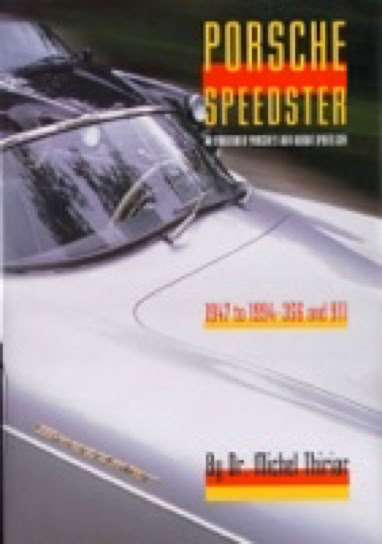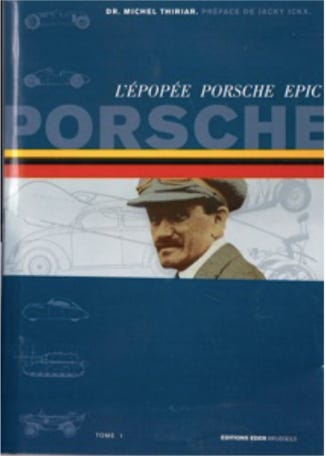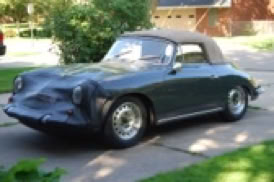TITLE Porsche Speedster
The Evolution of Porsche Light-Weight Sports Car
AUTHOR Thiriar
ENGLISH
ISBN 10 0929758153
ISBN 13 978092758152
CURRENTLY UNAVAILABLE @ BLOCKS BOOKS

Best history written on Speedsters; up through the 964 Carrera 2. Includes collectibles. Has become collectible — only one used copy without dust cover, but otherwise excellent, available at BLOCKS-BOOKS.
Also by this author:

TITLE Porsche Speedster
AUTHOR Thiriar
FRENCH
ISBN 10 29600099
ISBN 13 no ISBN 13
OUT OF PRINT --
CURRENTLY UNAVAILABLE @ BLOCKS BOOKS
TITLE Porsche Epic Volume 1 1875-1948
AUTHOR Thiriar
ENGLISH/FRENCH
ISBN 10 2960009959
ISBN 13 9782960009958
CURRENTLY UNAVAILABLE @ BLOCKS BOOKS

FROM MY REVIEWS IN THE PORSCHE 356 REGISTRY;
Dr. Michel Thiriar has the nerve to bring out a multi-volume history of Porsche. Karl Ludvigsen may find he is a little late to the marketplace. Where Excellence has about 80 pages dealing with early (up to the formation of Porsche as an automobile producer and the Professor Porsche’s death) in a 20 by 25 mm format, the entirety of Michael Thiriar’s Porsche Epic volume one is devoted to the pre-Porsche period. Porsche Epic volume one is a large format 30 by 25 mm book of 466 pages. Granted the tome (says so right on the front) is written in both French and English, still there coverage is overwhelming and definitive. The bibliography runs a solid 4 pages and there are an additional 4 pages of type numbers through 385. Perhaps Epic appears to be an epic to read, sort of a cross between inorganic chemistry and the history of anarchists in the Baltic. Fortunately, Michael is an amusing and frequently whimsical author. And if you don’t feel like reading, almost half the page area is composed of photographs -- not just the usual Porsche Arkivs, but photographs none of us has previously seen. A thesis is developed that Porsche moved from job to job because he wanted to experiment and his employers wanted focus and profits. Frequently Porsche’s moving on was the only thing that prevented bankruptcy. Porsche did amazingly well out of both wars. Immediately following the first world war, while people were starving in Vienna, Porsche built a hunting lodge in Carinthia (Gmund is in Carinthia) and a holiday home on the Worthersee as well treating himself to a yacht, the Argonaut. As Thiriar writes <With his usual excessiveness, Ferdinand fitted it with his 24-valve straight-six aircraft engine; its 350 horsepower gave the astonishing performance levels, to such an extent that the boat became the terror of the lake, capsizing other sailors’ skiffs with its wake>.
The post war period is covered in context. The contributions of rear engined Mercedes, Tatras, and even Skodas are examined as progenitors of the VW. Irrelevant in Nazi Germany, but after the war both VW and Porsche took some pains to claim originality. In the first history of Porsche, called fittingly enough Porsche, Richard von Frankenberg the first editor of the factory magazine Christophorus, attacked designer Barenyi’s claims to have first developed the central backbone, swing axle, rear engine horizontally opposed car. Writing under the pseudonym of Quint (for obvious if unsuccessful reasons) did not protect von Frankenberg from being sued.
From cars to tanks Porsche showed amazing originality and brilliance, but Thiriar well documents that the professor really had no grasp of suspension design. The Auto-Unions should have beaten Mercedes but suffered from poor road holding and the tanks had fragile suspensions. The war years makes fabulous reading. It is immediately clear that none of Porsche’s tanks were successful. All were over complicated, over budget and fragile. Porsche persisted in designing mixte (mixed motor-electric drive) tanks. But there was no copper available for electric motor windings. Except for Hitler’s unwavering support Porsche would have been sacked for the exact reasons that he left his previous employers. Even so, his brilliance is apparent. Who else would have had the nerve to suggest that Germany simply adapt the Russian T-34 tank?
We are also treated to photographs of the VW developmental cars and motors -- photographs and historical snippets not seen even in Karl Ludvigsen’s Battle for the Beetle.
Epic is an absolutely astounding book. It’s big, it’s lush, and it’s filled with lovely color. Who much and from whom? Currently I am trying to import the books from Belgium. But with a price of $120, given the recent drop of the dollar against the euro and the problems of shipping 5 kg books, I am not sure when or even if. Consider as well that there are going to be at least two and perhaps three more volumes dealing with Porsche the automobile company. I find it interesting that Porsche merits the efforts of Karl Ludvigsen and Michel Thiriar, who turn out scholarly books in the $100 range while the anniversary books for that front engine plastic car cost $39.95.




